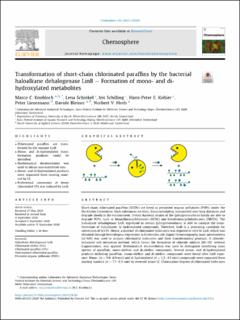Please use this identifier to cite or link to this item:
https://doi.org/10.21256/zhaw-26805| Publication type: | Article in scientific journal |
| Type of review: | Peer review (publication) |
| Title: | Transformation of short-chain chlorinated paraffins by the bacterial haloalkane dehalogenase LinB : Formation of mono- and di-hydroxylated metabolites |
| Authors: | Knobloch, Marco C. Schinkel, Lena Schilling, Iris Kohler, Hans-Peter E. Lienemann, Peter Bleiner, Davide Heeb, Norbert V. |
| et. al: | No |
| DOI: | 10.1016/j.chemosphere.2020.128288 10.21256/zhaw-26805 |
| Published in: | Chemosphere |
| Volume(Issue): | 262 |
| Issue: | 128288 |
| Issue Date: | 2021 |
| Publisher / Ed. Institution: | Elsevier |
| ISSN: | 0045-6535 1879-1298 |
| Language: | English |
| Subjects: | Chlorinated olefins (COs); Chlorinated paraffins (CPs); Haloalkane dehalogenase LinB; Hydroxylated chlorinated paraffins; Persistent organic pollutants (POPs); Biocatalysis; Environmental Monitoring; Environmental Pollutants; Escherichia coli; Halogenation; Hexachlorocyclohexane; Hydrocarbons, Brominated; Hydrocarbons, Chlorinated; Hydrolases; Hydroxylation; Paraffin; Sphingomonadaceae |
| Subject (DDC): | 660: Chemical engineering |
| Abstract: | Short-chain chlorinated paraffins (SCCPs) are listed as persistent organic pollutants (POPs) under the Stockholm Convention. Such substances are toxic, bioaccumulating, transported over long distances and degrade slowly in the environment. Certain bacterial strains of the Sphingomonadacea family are able to degrade POPs, such as hexachlorocyclohexanes (HCHs) and hexabromocyclododecanes (HBCDs). The haloalkane dehalogenase LinB, expressed in certain Sphingomonadacea, is able to catalyze the transformation of haloalkanes to hydroxylated compounds. Therefore, LinB is a promising candidate for conversion of SCCPs. Hence, a mixture of chlorinated tridecanes was exposed in vitro to LinB, which was obtained through heterologous expression in Escherichia coli. Liquid chromatography mass spectrometry (LC-MS) was used to analyze chlorinated tridecanes and their transformation products. A chloride-enhanced soft ionization method, which favors the formation of chloride adducts [M+Cl]- without fragmentation, was applied. Mathematical deconvolution was used to distinguish interfering mass spectra of paraffinic, mono-olefinic and di-olefinic compounds. Several mono- and di-hydroxylated products including paraffinic, mono-olefinic and di-olefinic compounds were found after LinB exposure. Mono- (rt = 5.9-6.9 min) and di-hydroxylated (rt = 3.2-4.5 min) compounds were separated from starting material (rt = 7.7-8.5 min) by reversed phase LC. Chlorination degrees of chlorinated tridecanes increased during LinB-exposure from nCl = 8.80 to 9.07, indicating a preferential transformation of lower chlorinated (Cl<9) tridecanes. Thus, LinB indeed catalyzed a dehalohydroxylation of chlorinated tridecanes, tridecenes and tridecadienes. The observed hydroxylated compounds are relevant CP transformation products whose environmental and toxicological effects should be further investigated. |
| URI: | https://digitalcollection.zhaw.ch/handle/11475/26805 |
| Fulltext version: | Published version |
| License (according to publishing contract): | CC BY 4.0: Attribution 4.0 International |
| Departement: | Life Sciences and Facility Management |
| Organisational Unit: | Institute of Chemistry and Biotechnology (ICBT) |
| Appears in collections: | Publikationen Life Sciences und Facility Management |
Files in This Item:
| File | Description | Size | Format | |
|---|---|---|---|---|
| 2021_Knobloch-etal_Transformation-of-chlorinated-paraffins-olefins_Chemosphere262.pdf | 2.55 MB | Adobe PDF |  View/Open |
Show full item record
Knobloch, M. C., Schinkel, L., Schilling, I., Kohler, H.-P. E., Lienemann, P., Bleiner, D., & Heeb, N. V. (2021). Transformation of short-chain chlorinated paraffins by the bacterial haloalkane dehalogenase LinB : Formation of mono- and di-hydroxylated metabolites. Chemosphere, 262(128288). https://doi.org/10.1016/j.chemosphere.2020.128288
Knobloch, M.C. et al. (2021) ‘Transformation of short-chain chlorinated paraffins by the bacterial haloalkane dehalogenase LinB : Formation of mono- and di-hydroxylated metabolites’, Chemosphere, 262(128288). Available at: https://doi.org/10.1016/j.chemosphere.2020.128288.
M. C. Knobloch et al., “Transformation of short-chain chlorinated paraffins by the bacterial haloalkane dehalogenase LinB : Formation of mono- and di-hydroxylated metabolites,” Chemosphere, vol. 262, no. 128288, 2021, doi: 10.1016/j.chemosphere.2020.128288.
KNOBLOCH, Marco C., Lena SCHINKEL, Iris SCHILLING, Hans-Peter E. KOHLER, Peter LIENEMANN, Davide BLEINER und Norbert V. HEEB, 2021. Transformation of short-chain chlorinated paraffins by the bacterial haloalkane dehalogenase LinB : Formation of mono- and di-hydroxylated metabolites. Chemosphere. 2021. Bd. 262, Nr. 128288. DOI 10.1016/j.chemosphere.2020.128288
Knobloch, Marco C., Lena Schinkel, Iris Schilling, Hans-Peter E. Kohler, Peter Lienemann, Davide Bleiner, and Norbert V. Heeb. 2021. “Transformation of Short-Chain Chlorinated Paraffins by the Bacterial Haloalkane Dehalogenase LinB : Formation of Mono- and Di-Hydroxylated Metabolites.” Chemosphere 262 (128288). https://doi.org/10.1016/j.chemosphere.2020.128288.
Knobloch, Marco C., et al. “Transformation of Short-Chain Chlorinated Paraffins by the Bacterial Haloalkane Dehalogenase LinB : Formation of Mono- and Di-Hydroxylated Metabolites.” Chemosphere, vol. 262, no. 128288, 2021, https://doi.org/10.1016/j.chemosphere.2020.128288.
Items in DSpace are protected by copyright, with all rights reserved, unless otherwise indicated.